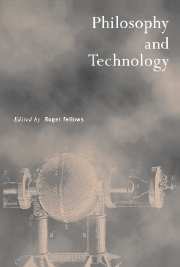Book contents
- Frontmatter
- Contents
- Introduction
- Technology: Liberation or Enslavement?
- Do the Successes of Technology Evidence the Truth of Theories
- Instrument and Reality: The Case of Terrestrial Magnetism and the Northern Lights (Aurora Borealis)
- Realism and Progress: Why Scientists should be Realists
- Quantum Technology: Where to Look for the Quantum Measurement Problem
- Welcome to Wales: Searle on the Computational Theory of Mind
- Acts, Omissions and Keeping Patients Alive in a Persistent Vegetative State
- Technology and Culture in a Developing Country
- Art and Technology: An Old Tension
- Tools, Machines and Marvels
- Values, Means and Ends
- Question Time
- Notes on Contributors
- Index of Names
Acts, Omissions and Keeping Patients Alive in a Persistent Vegetative State
Published online by Cambridge University Press: 27 October 2009
- Frontmatter
- Contents
- Introduction
- Technology: Liberation or Enslavement?
- Do the Successes of Technology Evidence the Truth of Theories
- Instrument and Reality: The Case of Terrestrial Magnetism and the Northern Lights (Aurora Borealis)
- Realism and Progress: Why Scientists should be Realists
- Quantum Technology: Where to Look for the Quantum Measurement Problem
- Welcome to Wales: Searle on the Computational Theory of Mind
- Acts, Omissions and Keeping Patients Alive in a Persistent Vegetative State
- Technology and Culture in a Developing Country
- Art and Technology: An Old Tension
- Tools, Machines and Marvels
- Values, Means and Ends
- Question Time
- Notes on Contributors
- Index of Names
Summary
Introduction: The Medical and Legal Background
There are many conflicting attitudes to technological progress: some people are fearful that robots will soon take over, even perhaps making ethical decisions for us, whilst others enthusiastically embrace a future largely run for us by them. Still others insist that we cannot predict the long term outcome of present technological developments. In this paper I shall be concerned with the impact of the new technology on medicine, and with one particularly agonizing ethical dilemma to which it has already given rise.
A patient lies in a hospital bed. He is not in a coma. He sleeps, wakes, sleeps again. His limbs remain crooked and taut but are capable of primitive reflex movements. The touch of bedclothes can elicit a grasp reflex. He sometimes chews, scratches, swallows, grinds his teeth. He may even grunt and groan. The patient's family, in hope, interprets these movements as signifying the stirrings of renewed mental activity. But the neurological experts shake their heads. They know that the patient is not clinically dead because the brain stem is intact. But he has suffered the almost total disintegration of his cerebral cortex. He is thus in a state of wakefulness without any kind of awareness: he neither sees, feels nor hears. He cannot communicate in any way. He is profoundly and permanently insensate. For, a person in this condition, the medical profession has coined an acronym: PVS. The patient, usually an accident victim, is in a ‘persistent vegetative state’.
- Type
- Chapter
- Information
- Philosophy and Technology , pp. 99 - 120Publisher: Cambridge University PressPrint publication year: 1995

